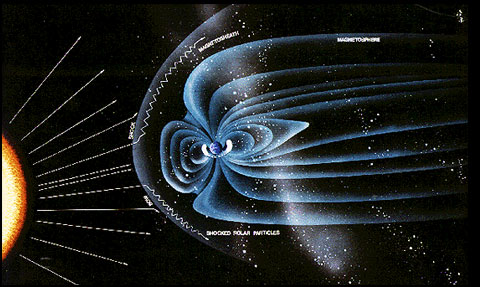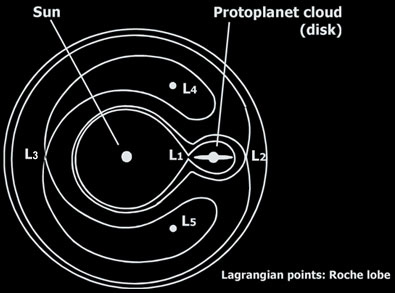by MLADEN MILLHOV, e-mail: /ad@planet-system.info/ the first edition 1996, the second edition 2003 |

ORIGIN of the SOLAR SYSTEMAll the hypotheses accept that the planets of the Solar System have formed one by one. The facts show that the planets of the Solar System have formed two by two. "The eyes can't see the facts, if there is no idea in the mind" - said the German philosopher Hegel. The study of binary stars is fundamental to all areas of astrophysics. It is amazing that no one till now guessed to apply the model of close binary system to the formation of planets. NASA's MESSENGER probe. |
Chapter 1 “Relic Phenomena”. A distinctive feature of our Solar System is that the planets are grouped in couples of similar sizes: Jupiter and Saturn, Uranus and Neptune, Pluto and Charon, Venus and the Earth. This fact could be explained in just one way: the planets have formed by couples of proto-planet clouds. As a working model I use the magnetosphere of the Earth scheme. Note that one of the protoplanet clouds in the couple is slightly bigger than the other. The same can be observed today with the sizes of the planets The closed magnetic lines of force imitate two protoplanet clouds.
Chapter 3. “Snowball” The formation of the planets of a gas-and-dust nebula resembles a lot the snow-men game. However, kids make snowballs with hands while the nebular hypothesis explains the consolidating of the planets with work. My model specifies the nebular hypothesis. Grouped in couples around Lagrangian points the protoplanet clouds have a bigger chance to form planets. Even more, my model explains a lot of other problems. First, why Venus, Uranus and Pluto have a retrograde spin? If the planets have formed one by one the mystery could be explained by accidental events. If the planets have formed in couples the mystery could be explained quite simply. One protoplanet turns left and the other right (the same explanation was already used for proto-galaxies). Chapter 4. “Quantization” The protoplanet clouds are quantized around Lagrangian points L1 and L2 in three separate phases. Instead of 9 we have 12 planets (See the table 4.1). Let us imagine these 12 protoplanet cores and gas-and-dust envelopes of approximately the same size. Why is there such a big difference today between the couples in sizes and density? An answer to that question and not only to it gives the next chapter. Table 4.1 Sizes and densities of the planets
Chapter 5. “Planetary Inbreeding” The law of distribution of the planetary orbits contains the 2n article, where (n) is natural number. Everyone of us has 2n ancestors n-generations back in time. Modern science considers that everything in the Universe changes. Today the center of the planet system is Jupiter. 4,6 billion years ago the center of the proto-planet disc probably was the Kuiper belt. Nowadays astronomers discover new bodies there as some of them are binary systems. The already formed planets fish out of their gas-and-dust envelopes and their quite elongated orbits gradually shorten till almost circular. That explains why around terrestrial planets there are no gases and dust. Jovian planets were attracted the gas-and-dust envelopes of terrestrial planets. Thus the equal quantization of proto-planet disc becomes today's unequal distribution of masses and density. The same can explain the satellite systems around Jovian planets as well as the rings around them. This assumption explains why Jovian planets' satellites have bigger density than the planets themselves. By the way Jovian planets' satellites are also grouped in couples of similar size and density (see the table 5.1). Table 5.1 Sizes of the satellites
Chapter 6. “The Moon” The most unique idea of my book is that the Moon formed a couple with Mercury and just subsequently it was trapped by the Earth. Mercury and the Moon are similar in size. There is a big resemblance between the surfaces of the two planets. Mercury has a big iron core and the Moon doesn't. The heavy elements in the protoplanet couple have “poured” into proto-Mercury. This model, like binary stars, suggests a mass exchange between the protoplanet clouds. The same mechanism is used for the explanation of why some planets have magnetic field and some don't. Chapter 7. “Physics and Biology” If all the planets of the Solar System have formed two by two, this will be the “missing link” in the cosmic evolution. On the one hand we have pairs of fundamental particles, double black holes, double galaxies and binary stars. On the other hand there is the dipole of water molecule, bilateral carbon atom, bilayered membranes, double helix of DNA, division of the cell, two sexes. Some examples of this principle of asymmetric duplication: E=mc2; Proton=2uquarks+dquark; massneutron=2masseselectron+massproton. Actually, the difference between masses of neutron and proton is approximately two electron masses. The residuum is either the electromagnetic mass of electron or a condition for the decay of proton. Chapter 8. “The Water” As in the other chapters, we will review two main problems here as well. First, the dipole of water molecule determines the most significant qualities of the biological solvent. Second, the Ice Ages. If we go back to Chapter 5 we will see that the Earth was not born here but where now the ice satellites of giant planets are (a connection to Snowball Earth theory). Besides, all the planets and satellites with rigid surface show a bilateral asymmetry. That fact in connection to all the others could be explained in just one way. Chapter 9. “Hypotheses” A historic retrospection of the different hypotheses for the origin of the Solar System. Chapter 10. “The Light” A description of processes running in the Sun. Chapter 11. “LGM” Origin of life and little green men Chapter 12. “Philosophy” The idea of my book is that all major processes in the Solar System were settled within the protoplanet couples. In that last chapter, I describe analogies (just analogies, nothing more) with history. In the human history there were many countries but just a few countries-counterparts set historical tendencies: Sumer and Akkad, Assyria and Babylonia, Sparta and Athens, Rome and Carthago, Eastern and Western Roman Empire, USA and USSR, etc. This chapter contains two special sentences. The idea of this book has analogies with the Gospel: the selection of the apostles two by two and the formation of the planets two by two, 12 apostles, one of which a traitor, 12 planets, one of which an unrealized (asteroids). * (This paragraph is not a part of the book) You can hardly find absolutely identical stars in binary systems. Nevertheless, the close binaries are born together and every star influences the evolution of the other one. The same for the planets of our Solar System. Maybe this is the main factor of the Solar System uniqueness. On the other hand, the postulate of the nebular hypothesis for great impacts between planets has never been proved. There are no signs of great impacts. On the contary, our Solar System is well-arranged in comparison to other planet systems. The question who remains is: Why the American astronomers are so attached to the impact hypotheses of the origin of the Solar system. The reasons may be: 1. Scientific 2. Cultural in nature. Every scientific theory reaches absurd, or infinity at the end. The nebular hypothesis is not an exception. Just imagine: a great impact who removed the Mercury's mantle, a second special impact who caused the retrograde rotation of Venus, a third very special impact who formed the Earth and the Moon, another impact who tilt Uranus axis and so on. Every one of these hypothetical impacts needed special conditions (mass, chemical composition, speed, trajectory of hypothetical bodies), so special that you need for example double impact in order to explain the formation of the Earth and the Moon. Maybe the problem is not in the science, but in the culture. In other words, the American politicians who wage wars and the American astronomers who explain the Solar System formation with great impacts are essence of one and the same cultural paradigm.
|
| All rights reserved © 2006-2024 www.planet-system.info |

